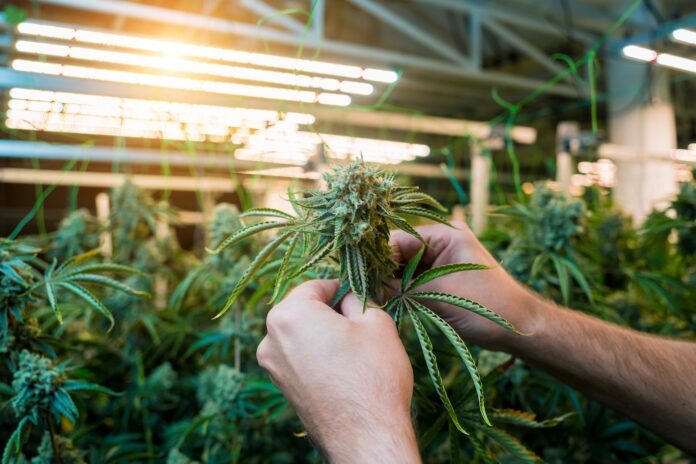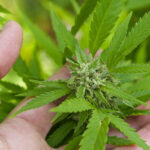The cannabis plant has existed on this planet for thousands of years. However, due to criminalization in the United States, research into agricultural best practices has remained limited. Historically, novice marijuana farmers mainly relied on word-of-mouth to learn how their plants grow best.
The underground nature of cannabis cultivation has allowed many myths to permeate the culture. And while there is some truth to certain old wives’ tales, like harvesting at night when the temperatures are cooler to protect volatile terpenes, many of the surviving fables are far from accepted fact in 2024.
We took a closer look at 10 popular cannabis cultivation myths — read on to find out if they’re fact or fiction.
More nutrients mean bigger, better plants
Adequate fertigation is one of the most important parts of marijuana farming, but much like the phosphorus myth below, too much of anything is never a good thing. Many novice marijuana farmers get overzealous with their feeding, a common mistake that can actually lead to nutrient burn or lockout, a type of plant stress that when not addressed can kill plants entirely. Early warning signs include yellowing of leaves or a severe darkening of stalks and branches.
Michelle Underwood, known as indoor growing expert MissRadReefer, understands the importance of balance.
“Less is usually more,” Underwood said. “Plants need many things to grow big and strong and provide bountiful fruits. Nutrients just fulfill one role of many needed, including sunlight, carbon dioxide, volume and frequency of water, along with proper temperate and humidity. Simply adding more nutrients can often lead to what growers call a nutrient lockout.
Cannabis is a creature of habit — any deviations from its regular schedule will only lead to trouble.
Grams per watt is a good measure of a farm’s performance
When determining whether an indoor or mixed light facility is successful, the “grams per watt” calculation is not the end-all-be-all, Kurt Kinneman, a Wisconsin-based cultivator and owner of Kinnektion Products. “Light is one important input for cannabis, but watering your plants, nutrients, labor, and other factors are also at play — and contribute to the overall operating costs. Additionally, producing buds doesn’t mean a farm is doing its best, especially if the resulting product is poor quality or fails required testing.”
Businesses are successful when they turn a profit, and the same can be said for cannabis grows. Metrics such as sales, customer satisfaction, and environmental impact are much better indicators of success versus sheer volume.
“A better and more accurate metric to measure a farm’s performance in the canopy is grams per sqft of canopy (or grams per square meter),” Underwood suggested. “This will give you a better idea of how much is produced in the space rather than an indication of the power used to grow it, as these days, not all farms are producing under the ancient standard of 1000w HPS over a 4’x4’ space.”
Drying plants upside down will increase bud potency
Hanging cannabis cola down during the drying phase is recommended by experts, but not because it boosts THC levels. It simply helps retain terpene and cannabinoid content by slowing down the process, giving remaining chlorophyll and sugars the proper time to be broken down. This allows for a more even cure, and a better overall smoking experience — but gaining more THC simply won’t happen.
“Potency will be determined by the plant’s development at harvest time,” said Bill Levers, a legacy grower turned writer and co-founder of Beard Bros.
“The only thing you could do from there to decrease THC is by handling it incorrectly,” he said. “We like to hang the whole plant upside down but one of our reasons is so that the sugar leaves will dry around the buds and protect them until trimming.”
Adding fruit to your soil can impart new flavors
When it comes to the way cannabis tastes, it’s all about the terpenes — not the dirt the plant was grown in. Terpenes are compounds found in all plants, responsible for their unique aromas and flavors. In cannabis, these molecules also help drive the overall effects of each cultivar.
Genetics determine the terpene profiles of any given strain, and while individual results may vary depending on factors like environmental conditions, putting extra fruit in the soil will not increase terp percentages or help cannabis plants produce new flavors.
“Microbes [in soil] can enhance the terpene profile,” noted Ted Blair, owner of Humboldt-based CannaCountry Farms. “But blending up fruit and throwing it down? No.”
Cannabis plants can’t use green light
The idea that cannabis doesn’t need green light due to its heavy chlorophyll content had been a fairly common notion until advancements in LED technology proved otherwise. Green light actually passes through the plant tissue at a better rate and can promote denser growth. Additionally, green light is less stressful than other colors on the light spectrum leading to a rise in the use of green headlights by farmers working at night.
You need tons of phosphorus to grow cannabis
Phosphorus is a crucial nutrient for all plants, promoting vegetative growth. But overdoing it on the mineral during feeding will not do a grower any favors. In fact, too much phosphorus can make buds harsh to smoke; many cultivators point to this as a reason to flush plants prior to harvest.
“It’s really all about maintaining balance,” said Kinneman. “In addition to potentially damaging the plants, feeding too much of one individual element can cause the plants to decrease their intake of other nutrients they need.”
Living soil leads to failed lab tests
Preventing the development of pathogens and mold is a crucial part of the cultivation process, especially since a failed test can spell disaster for an entire crop. Living soils do contain bacteria, helping to boost a plant’s immune health much like the microbiome in the human digestive system.
“Living soil actually protects the plant,” explains Northern California grower Ryan Harner. “The synergy between all those natural elements creates a natural defense against harmful bacteria and fungi.”
Harner adds the majority of microbial issues occur due to poor hygiene or overly humid conditions in drying, curing, and storage environments.
There’s only one right environment for cannabis cultivation
There are a lot of opinions in the broad cannabis community about which environment is best for cultivation. Outdoors, indoors, greenhouse — each has its diehard devotees. But the truth is that every type of operation has pros and cons: outdoor flower tends to be more sustainable and higher in terpenes but requires more physical labor, and the cured buds could lack bag appeal. Indoor cannabis offers more options for automation but tends to be heavily resource-intensive.
Prospective cultivators and cannabis companies need to consider the regulations in their state, their climate, and their overall production goals when deciding which type of environment they want to build out.
You can tell a male from a female seed by how it looks
The vast majority of cultivators in the cannabis industry hope for female plants as they are the ones that produce bountiful buds, but trying to spot a difference between male and female seeds is simply impossible. The only way to determine whether a quality seed will result in a male or female plant is through genetic testing. Many in large-scale cannabis production who want a sure bet will utilize feminized cannabis seeds, which are specifically bred to produce female marijuana plants.
“A lot of people think they know if a seed is male or female from looking at it, but there’s just no way,” Kinneman said.
If left to chance, growers will be able to learn the sex of their plants by inspecting the nodes when the branches begin to grow off the stalk. Male plants will have small bumps indicative of pollen sacks while female marijuana plants will develop small, hairy flower clusters.
Cannabis grown in certain regions is superior
Whether it’s the Emerald Triangle or the Hindu Kush mountains, certain well-known cannabis-producing regions have developed hardcore fanbases that tout the unique characteristics of the native flower. But similar to the indoor vs. outdoor debate, it all comes down to personal preference, not calculated measurements of quality.
The designation of cannabis terroirs, or the practice of recognizing regions for their unique environments’ effect on their native plants, seeks to protect and honor places known for their landrace strains. However, the concept does not determine which environment is the “best” — it simply identifies their unique characteristics, similar to winemaking regions.











[…] Managing cannabis nutrients is key for healthy weed plant feeding. The idea that more marijuana fertilizer means better growth is wrong. It can cause “nutrient burn.”8 […]
[…] https://mgmagazine.com/business/growing-horticulture/10-cannabis-farming-myths-many-still-believe/ […]
[…] https://mgmagazine.com/business/growing-horticulture/10-cannabis-farming-myths-many-still-believe/ […]